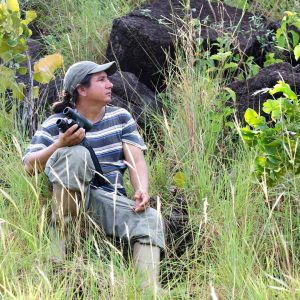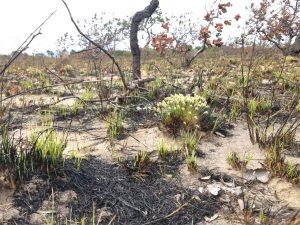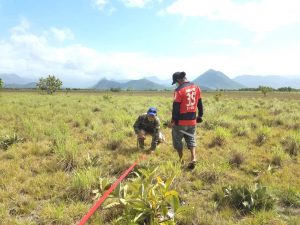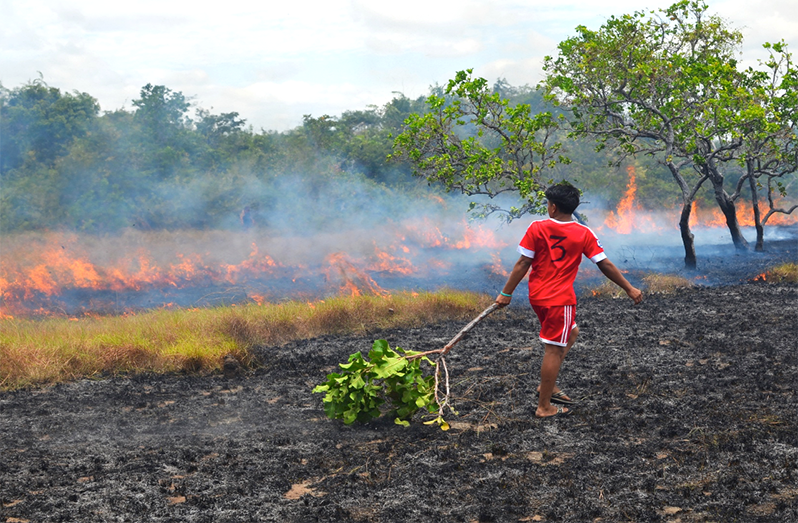WITH wildlife increasingly at risk due to regular occurrences of fires in the Rupununi, the South Rupununi Conservation Society’s (SRCS) newest project to collect data on the issue can potentially fix some of the problems associated with wildfires.
The Rupununi savannahs are natural, and fires are a common occurrence in the area, particularly in the dry season. While some of these fires at times have natural causes, many indigenous people use fire in their daily lives to create farms, manage their pastures, and hunt for food, among other things.

Of particular concern is that while these fires are relatively small in the savannahs, they can enter the forest in very dry seasons. Further, it is difficult to assess how wildlife reacts to fire over time because ecosystem dynamics are unstable and fluctuate in response to climate change, human activities, and other factors.
For this reason, the SRCS is piloting its new project, called the Impact of Fire on Wildlife, as it believes that it is important to understand the response of wildlife to fire because not a lot is known about it. If this pilot is successful, it can serve as a baseline for the Rupununi and also as an example for other places on how they can collect information on fires and wildlife.
“Rupununi wildlife is one of the major draws for tourism, and a better understanding of fire’s impact on wildlife can help contribute to decisions about fire management in the Rupununi savannas,” SRCS President Leroy Ignacio told the Pepperpot Magazine.
With funding from the Sustainable Wildlife Management programme, SRCS is working with a local team in Shulinab Village to set transects in key areas in the savannah and at the forest edge. These will be monitored twice a month by a three-person ‘fire team,’ who will record information on plants and animals.
For wildlife, the SRCS wants to assess how animals use burnt and unburnt areas with a primary focus on birds and mammals, but also a secondary focus on reptiles and amphibians. The team will be looking for live sightings of animals using burnt or regenerating habitats, and for any animals that may have perished in fires.

The SRCS also want to understand what plants are fire-adapted, what vegetation grows back after a fire, how fast, and under what conditions. “An understanding of how fire interacts with plants and the environment can help us understand how fire impacts wildlife and the behaviour of animals,” Ignacio noted.
A recently conducted training focused on using smartphones and an app called KoboCollect with forms designed for this project to record information. The training also touched on GPS use and how to set and monitor the fire transects.
Part of this project will also focus on freshly burnt areas and the team will record any immediate effects on wildlife, which animals are using the area after a fire, or maybe which ones have been affected, either injured or killed.
The SRCS is also building on work that is being done on fire in the Rupununi. Shulinab Village already has a fire- management plan, which they developed in 2019, and identified key areas where fires posed a risk, as well as an established fire committee that is responsible for making decisions about fire management in the village.

The SRDC, which represents the South Central and South Rupununi communities also have a territorial plan within which they identify key areas for protection, and outline the importance of fire management in the Rupununi. Using this information and in discussion with Shulinab village’s fire committee, the areas were chosen to set the transects.
The local SRCS fire team from Shulinab includes Maxi Ignace (who is collecting information on birds), Susan Balvadore (who is collecting information on mammals, amphibians, and reptiles), Nicholas Mandookin and/or Allan Mandookin (who will be collecting information on vegetation and the interaction of fire with the environment).
This team is supported by Dr. Brian O’Shea from North Carolina Museum of Natural Sciences ( providing technical support on birds and data analysis), Dr. Evi Paemelaere, People and Wildlife Solutions (providing technical support on KoboCollect design and data analysis on mammals), and Dr. Matt Hallet from University of Florida, Jacksonville Zoo and Gardens (technical support for mammals and data analysis).



.jpg)











